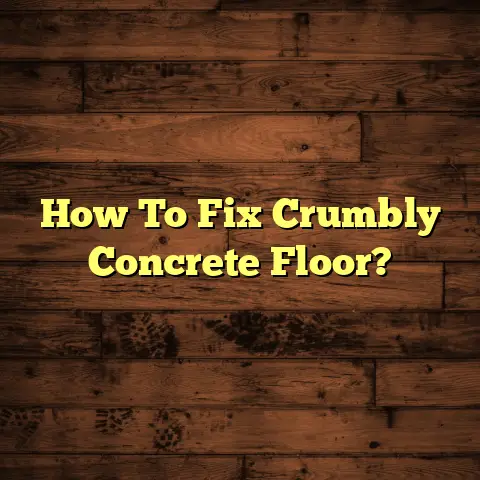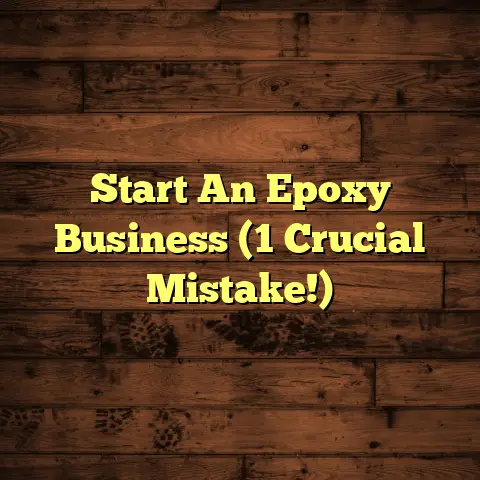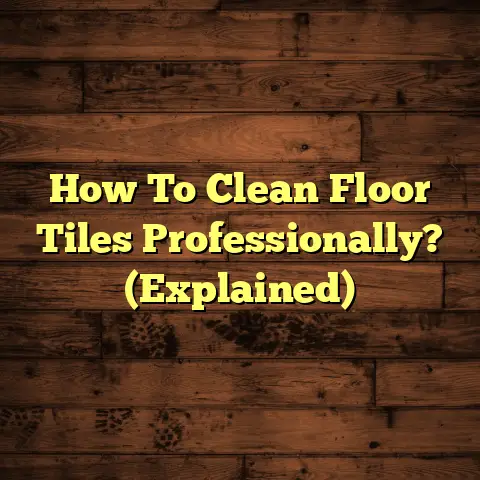Backer Board For Tile: Is It Needed? (3 Must-Knows)
Are you someone who enjoys DIY home improvement projects? Or do you prefer to hire professionals for renovations?
Regardless, understanding the materials you use is crucial, especially when it comes to flooring and tiling. Let’s dive into backer board and figure out if you really need it for your next tiling job.
Section 1: Understanding Backer Board
Okay, so what is backer board anyway?
Simply put, it’s a tile substrate. Think of it as the foundation upon which you’ll lay your beautiful tiles. It provides a stable, flat, and most importantly, moisture-resistant surface.
Why is that last bit so important? Because tile alone isn’t waterproof! Moisture can seep through the grout lines and wreak havoc on the underlying structure.
Different Types of Backer Board
Now, let’s talk about the different flavors of backer board you’ll find at your local home improvement store. I’ve used them all, and each has its pros and cons.
-
Cement Board: This is the workhorse of the backer board world. It’s made from cement, reinforced with fibers. It’s incredibly durable, water-resistant, and can handle heavy loads. Brands like Durock and HardieBacker are popular.
-
Foam Board: These are lightweight panels made of foam, often coated with a waterproof membrane. They’re easy to cut and install, making them a DIYer’s friend. Schluter Kerdi-Board is a well- known brand.
-
Green Board: Technically known as moisture- resistant drywall. I really don’t recommend using this as a tile backer, especially in wet areas! It’s better than regular drywall, but it’s still susceptible to moisture damage over time.
Why Backer Board Matters
The main reason we use backer board is to create a stable and moisture-resistant surface for our tile. Think of it like this:
Imagine building a house on a shaky foundation. It’s not going to last long, right? The same goes for tile. If you install tile directly onto a surface that’s not stable or that absorbs moisture, you’re asking for trouble.
Backer board prevents:
-
Tile Cracking: Uneven surfaces or movement underneath the tile can cause it to crack. Backer board provides a solid, unyielding base.
-
Water Damage: As I mentioned before, tile and grout aren’t waterproof. Water can seep through and damage the subfloor, leading to mold growth and structural problems.
-
Grout Failure: A flexible substrate can cause grout to crack and crumble over time. Backer board minimizes movement and helps keep your grout lines intact.
Section 2: The Importance of Backer Board
in Tile Installation
Okay, so we know what backer board is, but why is it so important? Let’s get into the nitty-gritty details.
Preventing Tile Cracking and Water Damage
This is the big one. Tile cracking and water damage are the two biggest headaches you’ll face if you skip the backer board (or use the wrong type).
Think about it:
Your shower floor is constantly exposed to water. That water will find its way through the grout lines, no matter how well you seal it. If there’s no backer board to protect the subfloor, that water will eventually cause rot, mold, and structural damage.
Similarly, if your subfloor is uneven or prone to movement, the tile will flex and crack under the stress. Backer board acts as a buffer, absorbing that stress and preventing the tile from failing.
Extending the Lifespan of Your Tile
A properly installed tile job with backer board can last for decades. I’ve seen tile installations that are 50+ years old and still look great, thanks to a solid foundation.
On the other hand, I’ve also seen tile jobs fail within a few years because the installer cut corners and skipped the backer board. It’s really not worth the risk!
Spending the extra time and money on backer board is an investment in the longevity of your tile. You’ll save yourself a lot of headaches (and money) in the long run.
Failure Rates: The Numbers Don’t Lie
While hard numbers can be tricky to nail down, industry experts agree that tile installations without proper backer board have a significantly higher failure rate.
Anecdotally, I’d say I’ve seen at least twice as many tile failures due to improper substrate preparation compared to failures caused by other factors like poor installation techniques or low- quality tile.
Think about it this way:
A study by the Tile Council of North America (TCNA) found that substrate preparation is one of the most critical factors in the success of a tile installation. While they don’t give specific failure rates, they emphasize the importance of using appropriate backer board for the application. (https://www.tileusa.com/)
I’ve personally seen countless bathrooms where the tile floor had to be completely ripped out and re-done because the original installer used drywall instead of backer board. The cost of demolition, materials, and labor can easily run into the thousands of dollars.
Section 3: When Backer Board is Necessary
and When It’s Not
Alright, so now we know that backer board is usually a good idea. But are there situations where you can get away without it? Let’s break it down.
Wet Areas vs. Dry Areas
This is the most important distinction.
-
Wet Areas: Showers, bathrooms, laundry rooms, and kitchens (especially around the sink) always require backer board. There’s no getting around it. The constant exposure to moisture makes backer board an absolute necessity.
-
Dry Areas: This is where things get a little more nuanced. In dry areas like living rooms, bedrooms, or hallways, you might be able to get away with using a different substrate, like plywood or even drywall in some cases.
However, even in dry areas, I still recommend using backer board whenever possible. It provides a more stable and durable surface, and it’s simply a better long-term investment.
Alternative Substrates: Proceed with Caution
Okay, let’s say you’re tiling a dry area and you’re considering using an alternative substrate. Here are a few options, along with my thoughts:
-
Plywood: Exterior-grade plywood can be used as a substrate for tile in dry areas, but it needs to be thick enough to prevent flexing. I recommend at least 3/4-inch thickness. Make sure it’s properly fastened to the floor joists to prevent movement.
-
Drywall: I generally advise against using drywall as a tile substrate, even in dry areas. It’s simply not designed to handle the weight and moisture that tile installations can be exposed to. However, in very specific situations, like tiling a small backsplash in a dry kitchen, it might be acceptable. But proceed with extreme caution!
-
Existing Tile: You can sometimes tile over existing tile, but only if the existing tile is in good condition and properly bonded to the subfloor. You’ll need to thoroughly clean and prepare the existing tile surface before applying the new tile. I prefer to remove the old tile and start fresh with backer board.
Important Note: If you’re considering using an alternative substrate, consult with a qualified tile installer or building inspector to make sure it’s appropriate for your specific application.
Local Building Codes and Regulations
Finally, don’t forget to check your local building codes and regulations. Many jurisdictions have specific requirements for tile installations, including the type of backer board that must be used in certain areas.
Failing to comply with local building codes can result in fines, delays, and even the need to redo the entire project. It’s always better to be safe than sorry!
You can usually find information about local building codes on your city or county’s website. You can also contact your local building department directly.
A quick story:
I once worked on a bathroom remodel where the homeowner had installed drywall as a tile substrate in the shower. The building inspector caught it during the rough-in inspection and made them rip it all out and replace it with cement board. It was a costly and time-consuming mistake that could have been avoided by simply checking the local building codes beforehand.
Conclusion
So, is backer board always needed for tile installations?
The short answer is no, but it’s almost always a good idea.
In wet areas, backer board is an absolute necessity. In dry areas, you might be able to get away with using an alternative substrate, but proceed with caution and always consult with a professional.
Ultimately, the decision of whether or not to use backer board depends on your specific project, your budget, and your risk tolerance. But remember, cutting corners on substrate preparation can lead to costly problems down the road.
By being informed about the materials you use in your home improvement projects, you can make better decisions and achieve better outcomes. And that’s what it’s all about, right?
Happy tiling!





